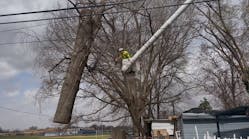Urban Trees Present a Significant Challenge
Known as the Garden City, Belo Horizonte — the capital of Minas Gerais, located in southeastern Brazil — has more than 300,000 trees with a green area index of 27.1 sq m/habitant (292 sq ft/inhabitant) and 42 urban parks, such as Américo Renné Giannetti in the downtown and Mangabeiras Park in the southern part of the city, an area that includes a native forest.
Belo Horizonte is the first planned city in Brazil, based on the style of European cities. It has a population of 2.75 million living in an area of 335 sq km (129 sq miles). With altitudes ranging from 750 m to 1,390 m (2,461 ft to 4,561 ft), this city has a tropical climate with temperatures ranging between 18°C and 22°C (64°F to 72°F) throughout the year. In the last five years, there has been a huge increase of trees falling due to wind, rain or lightning. On rainy days, an average of 20 to 30 trees fall, causing damage and accidents.
The Energy Co. of Minas Gerais (Cemig) is responsible for electricity distribution in the city. Every year, 20% of its network faults, causing loss of supply to customers, occur because of branches and trees falling on urban distribution overhead lines. In 2011, almost R$10 million was spent on tree management in urban areas. More than 90% of tree management work is undertaken by conventional techniques with the network live, 2% to 5% is completed using live-line techniques and the remainder requires a system shutdown.
The Distribution Network
Cemig Distribution's service area covers 568,000 sq km (219,000 sq miles), which is about 96% of the state of Minas Gerais. The state includes 774 cities and 5,415 villages, and has a population of 18.2 million, according to the 2007 census.
Cemig is the largest distributor of electric power in Latin America and the fourth in the world, having a low-voltage distribution network that extends to 58,000 km (36,000 miles) in urban areas and a medium-voltage network of 34,000 km (21,000 miles) in urban areas. In Belo Horizonte, the distribution network is 6,939 km (4,312 miles).
Wind Corridor Project
In 2010, Cemig Distribution's management planning and maintenance department in partnership with the Premiar program — an integrated tree and network management program created by Cemig together with the Belo Horizonte City Hall — supported a project with Pontífica Universidade Católica de Minas Gerais. As part of this project, investigators have studied major weather events in Belo Horizonte in recent years and, in particular, the details of the last three rainy seasons.
This project, called Wind Corridor, aims to determine the displacement of major storms and establish a monitoring and early warning system to reduce the impact of the meteorological events on urban distribution network equipment. The research undertaken to date is based on meteorological data recorded by automatic stations that includes information on wind gusts, satellite images and meteorological data on lightning. The possibility of channeling winds has been analyzed with particular consideration being given to the urbanization and topography of the city, known as urban canyons.
Survey Results
The survey results show there is a direct relationship between severe weather events and falling trees. According to the Beaufort scale, the wind gusts in Belo Horizonte are very strong winds with speeds between 45 kmph to 77 kmph (28 mph to 48 mph). However, there was a wind gust in March 2010 with a speed of 94 kmph (58 mph)
The data comparison of wind speed in recent years shows the intensity and number of days with damaging wind gusts have increased significantly. In Belo Horizonte, the average wind speed is 12 kmph (7.5 mph), but with the increase of severe weather events in the city, it is now a major concern to determine the correct management of urban trees. Therefore, the effects of climate change should be considered in the planning and siting of future urban trees to limit the number of falling trees and the consequential damage and impact on electricity supplies.
The wind rose for Belo Horizonte confirms the prevailing wind direction (43%) is from the east. This is attributable to the maritime tropical air mass, which acts between Brazil and Africa, and is characterized by the hot weather, dry and calm winds.
The storms that occur in Belo Horizonte are in six different locations:
-
In region 1, the storms are formed in the southern metropolitan region of Belo Horizonte and associated with the formation of convective processes. Heavy rains are usually located in some of this region's neighborhoods.
-
In region 2, the rains are intense and organized by convective formations but associated with the passage of cold fronts.
-
In regions 3 and 4, the storms usually result from the passage of cold fronts; however, in region 4, the systems also are associated with the presence of the convergence zone in the South Atlantic.
-
In region 5, storms occur rarely and faults are associated with the instability of overhead lines.
-
In region 6, the storms are severe and often occur about once or twice a year, forming behind the frontal systems.
Plan for the Future
Cemig believes the results of its Wind Corridor project allowed for the development of research to evaluate, in greater detail, the effect of urban heat islands in cities and the real impact of those climate changes on electric power distribution systems. The work also will facilitate analysis and studies to determine the most appropriate tree species for planting in urban areas with higher incidence of wind gusts caused by severe storms.
Based on the results of this project to date, it is possible to establish levels of alerts for all types of storms as a function of each particular region of Belo Horizonte:
-
Alert level 1 to storms that form in regions 1 and 5
-
Alert level 2 to storms that form in regions 2 and 6
-
Alert level 3 to storms coming from regions 3 and 4, which are the most severe and affect the whole city.
This systematization of alerts will allow operational mangers to plan for the crews, positioning and resources necessary to normalize interruptions caused by storm damage to the electricity distribution networks.
The studies enabled Cemig to educate the municipality of Belo Horizonte that an increase in the number of anemometers in the city was needed. Earlier this year, Mayor Márcio Lacerda requested the municipal council for environmental issues to initiate a study for the acquisition of anemometers to establish municipal monitoring of wind gusts. With this initiative, Cemig believes the network anemometers would provide information to determine an improved level of understanding of the dynamics of the wind in urban canyons, and its intensity and impact in urban areas.
Ruibran Januário dos Reis ([email protected]) graduated in meteorology from the Universidade Federal do Rio de Janeiro and received his doctorate degree in geography from the Pontífica Universidade Católica de Minas Gerais, where he works as professor of climatology and climate change for graduation and post-graduation geography classes.
Carlos Alberto de Sousa ([email protected]) is the coordinator of the Premiar program at Cemig. De Sousa is a marketing professional with more than 10 years of working experience in project management coordination for utility agencies. He promotes best practices in project management and is a member of the Utility Arborist Association, Game Theory Society and Supervisory Board of the Institute of Project Management in Minas Gerais.
Henrique Diniz ([email protected]) received a BSEE degree from the Federal University of Minas Gerais, Belo Horizonte, in 2004. He has seven years experience working as an engineer for large power utilities in Brazil and is currently employed by Cemig.
Luciano Satlher dos Reis ([email protected]) graduated in agricultural engineering from the Universidade Federal de Viçosa and now works as an arborist for PRB Ambiental in Belo Horizonte.
Construction Types
Cemig Distribution has an urban medium-voltage overhead line network that extends 33,719 km (20,952 miles), of which 26,429 km (16,422 miles) is constructed with bare conductors, 6,985 km (4,340 miles) with spacer conductors and 306 km (190 miles) with insulated conductors. The low-voltage overhead line network in urban areas is 35,731 miles (57,504 km).
Cemig has a standard based on load density and tree population that is used to determine medium-voltage network design standards. Spacer cables are used where interference from trees is not considered a problem and the load density is less than 12 MW/sq km (19.3 MW/sq mile). Insulated conductors are used in areas where trees are regarded a problem. Underground cables are only used in urban areas where the load density exceeds 12 MW/sq km. All medium-voltage overhead line new construction and refurbishment work is now completed using spacer conductors as a minimum.
Company mentioned:
Cemig | www.cemig.com.br

